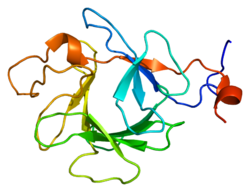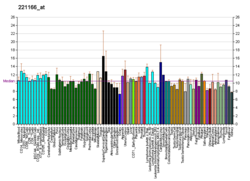Fibroblast growth factor 23
Fibroblast growth factor 23 or FGF23 is a protein that in humans is encoded by the FGF23 gene.[5] FGF23 is a member of the fibroblast growth factor (FGF) family which is responsible for phosphate and vitamin D metabolism.[6][7]
Function
The main function of FGF23 seems to be regulation of phosphate concentration in plasma. FGF23 is secreted by osteocytes in response to elevated calcitriol. FGF23 acts on the kidneys, where it decreases the expression of NPT2, a sodium-phosphate cotransporter in the proximal tubule.[8] Thus, FGF23 decreases the reabsorption and increases excretion of phosphate. FGF23 may also suppress 1-alpha-hydroxylase, reducing its ability to activate vitamin D and subsequently impairing calcium absorption.[7]
Clinical significance
FGF23 is located on chromosome 12 and is composed of three exons. Mutations in FGF23 that render the protein resistant to proteolytic cleavage leads to increased activity of FGF23 and the renal phosphate loss found in the human disease autosomal dominant hypophosphatemic rickets. FGF23 is also overproduced by some types of tumors, such as the benign mesenchymal neoplasm Phosphaturic mesenchymal tumor causing tumor-induced osteomalacia, a paraneoplastic syndrome.[9] Loss of FGF23 activity is thought to lead to increased phosphate levels and the clinical syndrome of familial tumor calcinosis. This gene was identified by its mutations associated with autosomal dominant hypophosphatemic rickets.[10] Prior to discovery in 2000, it was hypothesized that a protein existed which performed the function of FGF23. This putative protein was known as phosphatonin.Two major types of effects • Direct Effects: • 1. Impairs sodium dependent phosphate transport in both intestinal and renal brush border membrane vesicles • 2. Inhibits production of calcitriol and stimulates breakdown of calcitriol • 3. Inhibits production/secretion of parathyroid
References
- ^ a b c GRCh38: Ensembl release 89: ENSG00000118972 – Ensembl, May 2017
- ^ a b c GRCm38: Ensembl release 89: ENSMUSG00000000182 – Ensembl, May 2017
- ^ "Human PubMed Reference:". National Center for Biotechnology Information, U.S. National Library of Medicine.
- ^ "Mouse PubMed Reference:". National Center for Biotechnology Information, U.S. National Library of Medicine.
- ^ Yamashita T, Yoshioka M, Itoh N (October 2000). "Identification of a novel fibroblast growth factor, FGF-23, preferentially expressed in the ventrolateral thalamic nucleus of the brain". Biochem. Biophys. Res. Commun. 277 (2): 494–8. doi:10.1006/bbrc.2000.3696. PMID 11032749.
- ^ Fukumoto S (2008). "Physiological regulation and disorders of phosphate metabolism--pivotal role of fibroblast growth factor 23". Intern. Med. 47 (5): 337–43. doi:10.2169/internalmedicine.47.0730. PMID 18310961.
- ^ a b Perwad F (2007). "Fibroblast growth factor 23 impairs phosphorus and vitamin D metabolism in vivo and suppresses 25-hydroxyvitamin D-1alpha-hydroxylase expression in vitro". Am J Physiol Renal Physiol. 293: F1577-83. doi:10.1152/ajprenal.00463.2006. PMID 17699549.
- ^ Jüppner H (2011). "Phosphate and FGF-23". Kidney Int. Suppl. 79 (121): S24–7. doi:10.1038/ki.2011.27. PMC 3257051. PMID 21346724.
- ^ Zadik Y, Nitzan DW (October 2011). "Tumor induced osteomalacia: A forgotten paraneoplastic syndrome?". Oral Oncol. 48 (2): e9–10. doi:10.1016/j.oraloncology.2011.09.011. PMID 21985764.
- ^ "Entrez Gene: FGF23 fibroblast growth factor 23".
Further reading
- Kiela PR, Ghishan FK (January 2009). "Recent advances in the renal-skeletal-gut axis that controls phosphate homeostasis". Lab. Invest. 89 (1): 7–14. doi:10.1038/labinvest.2008.114. PMID 19029978.
- Silve C, Beck L (2003). "Is FGF23 the long sought after phosphaturic factor phosphatonin?". Nephrol. Dial. Transplant. 17 (6): 958–61. doi:10.1093/ndt/17.6.958. PMID 12032180.
- Quarles LD (2003). "FGF23, PHEX, and MEPE regulation of phosphate homeostasis and skeletal mineralization". Am. J. Physiol. Endocrinol. Metab.. 285 (1): E1–9. doi:10.1152/ajpendo.00016.2003. PMID 12791601.
{{cite journal}}: Unknown parameter|doi_brokendate=ignored (|doi-broken-date=suggested) (help) - Fukagawa M, Nii-Kono T, Kazama JJ (2005). "Role of fibroblast growth factor 23 in health and in chronic kidney disease". Curr. Opin. Nephrol. Hypertens. 14 (4): 325–9. doi:10.1097/01.mnh.0000172717.49476.80. PMID 15930999.
- Imel EA, Econs MJ (2006). "Fibroblast growth factor 23: roles in health and disease". J. Am. Soc. Nephrol. 16 (9): 2565–75. doi:10.1681/ASN.2005050573. PMID 16033853.
- Liu S, Quarles LD (2007). "How fibroblast growth factor 23 works". J. Am. Soc. Nephrol. 18 (6): 1637–47. doi:10.1681/ASN.2007010068. PMID 17494882.
- Econs MJ (2000). "Autosomal dominant hypophosphataemic rickets is associated with mutations in FGF23". Nat. Genet. 26 (3): 345–8. doi:10.1038/81664. PMID 11062477.
- White KE, Jonsson KB, Carn G, Hampson G, Spector TD, Mannstadt M, Lorenz-Depiereux B, Miyauchi A, Yang IM, Ljunggren O, Meitinger T, Strom TM, Jüppner H, Econs MJ (2001). "The autosomal dominant hypophosphatemic rickets (ADHR) gene is a secreted polypeptide overexpressed by tumors that cause phosphate wasting". J. Clin. Endocrinol. Metab. 86 (2): 497–500. doi:10.1210/jc.86.2.497. PMID 11157998.
- Shimada T, Mizutani S, Muto T, Yoneya T, Hino R, Takeda S, Takeuchi Y, Fujita T, Fukumoto S, Yamashita T (2001). "Cloning and characterization of FGF23 as a causative factor of tumor-induced osteomalacia". Proc. Natl. Acad. Sci. U.S.A. 98 (11): 6500–5. Bibcode:2001PNAS...98.6500S. doi:10.1073/pnas.101545198. PMC 33497. PMID 11344269.
- Bowe AE, Finnegan R, Jan de Beur SM, Cho J, Levine MA, Kumar R, Schiavi SC (2001). "FGF-23 inhibits renal tubular phosphate transport and is a PHEX substrate". Biochem. Biophys. Res. Commun. 284 (4): 977–81. doi:10.1006/bbrc.2001.5084. PMID 11409890.
- White KE, Carn G, Lorenz-Depiereux B, Benet-Pages A, Strom TM, Econs MJ (2002). "Autosomal-dominant hypophosphatemic rickets (ADHR) mutations stabilize FGF-23". Kidney Int. 60 (6): 2079–86. doi:10.1046/j.1523-1755.2001.00064.x. PMID 11737582.
- Kruse K, Woelfel D, Strom TM, Storm TM (2002). "Loss of renal phosphate wasting in a child with autosomal dominant hypophosphatemic rickets caused by a FGF23 mutation". Horm. Res. 55 (6): 305–8. doi:10.1159/000050018. PMID 11805436.
- Yamashita T, Konishi M, Miyake A, Inui K, Itoh N (2002). "Fibroblast growth factor (FGF)-23 inhibits renal phosphate reabsorption by activation of the mitogen-activated protein kinase pathway". J. Biol. Chem. 277 (31): 28265–70. doi:10.1074/jbc.M202527200. PMID 12032146.
{{cite journal}}: CS1 maint: unflagged free DOI (link) - Saito H, Kusano K, Kinosaki M, Ito H, Hirata M, Segawa H, Miyamoto K, Fukushima N (2003). "Human fibroblast growth factor-23 mutants suppress Na+-dependent phosphate co-transport activity and 1alpha,25-dihydroxyvitamin D3 production". J. Biol. Chem. 278 (4): 2206–11. doi:10.1074/jbc.M207872200. PMID 12419819.
{{cite journal}}: CS1 maint: unflagged free DOI (link) - Bai XY, Miao D, Goltzman D, Karaplis AC (2003). "The autosomal dominant hypophosphatemic rickets R176Q mutation in fibroblast growth factor 23 resists proteolytic cleavage and enhances in vivo biological potency". J. Biol. Chem. 278 (11): 9843–9. doi:10.1074/jbc.M210490200. PMID 12519781.
{{cite journal}}: CS1 maint: unflagged free DOI (link) - Larsson T, Zahradnik R, Lavigne J, Ljunggren O, Jüppner H, Jonsson KB (2003). "Immunohistochemical detection of FGF-23 protein in tumors that cause oncogenic osteomalacia". Eur. J. Endocrinol. 148 (2): 269–76. doi:10.1530/eje.0.1480269. PMID 12590648.
- Campos M, Couture C, Hirata IY, Juliano MA, Loisel TP, Crine P, Juliano L, Boileau G, Carmona AK (2003). "Human recombinant endopeptidase PHEX has a strict S1' specificity for acidic residues and cleaves peptides derived from fibroblast growth factor-23 and matrix extracellular phosphoglycoprotein". Biochem. J. 373 (Pt 1): 271–9. doi:10.1042/BJ20030287. PMC 1223479. PMID 12678920.
This article incorporates text from the United States National Library of Medicine, which is in the public domain.







